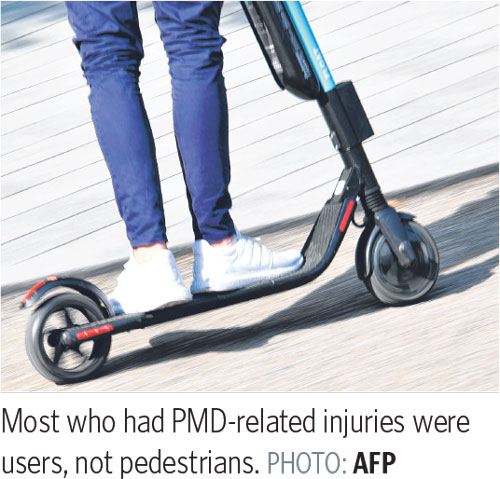The New Paper (22 October 2019)
Almost all its 213 PMD-related patients since 2017 were users, and 41% of injuries involved head and neck
At least six people have died from using personal mobility devices (PMDs) since 2017, according to latest figures from Tan Tock Seng Hospital (TTSH).
Its trauma ward doctors have also seen a spike in the number of patients involved in PMD-related incidents and warned that the trend is likely to continue.

At a media briefing yesterday, the hospital revealed that the six riders who died were 30 to 67 years old.
One suffered a spinal injury, but almost all of them had some form of brain injury, said Dr Sunder Balasubramaniam, an associate consultant at TTSH’s trauma and acute care surgery department.
“Usually (brain injury) is the one that tends to matter, because the amount of intervention that can make a difference is not as much as some of the other patients,” he said.
This echoes broader numbers that TTSH has collated since 2017, which show that head and neck injuries make up a majority of PMD-related injuries.
They accounted for 41 per cent of the 303 injuries reported, followed by external injuries such as abrasions and lacerations at 26 per cent and facial injuries at 12 per cent.
TTSH treated 87 patients who were involved in PMD-related incidents last year, an 85 per cent jump from the 47 patients in 2017.
The first nine months of this year have already seen 79 such patients, an almost 70 per cent rise from the whole of 2017.
The vast majority of these patients were PMD users. The youngest was a two-year-old pillion rider who suffered a head injury. The oldest was a 90-year-old rider.
Just six of the 213 patients treated at TTSH for PMD-related injuries were pedestrians.
Apart from one who had severe injuries, they mostly had minor head injuries.
An earlier study published in July this year had looked at national PMD-rider injury rates between 2015 and 2017.
The study found that users of motorised PMDs were thrice as likely as users of manual devices, like kick scooters, to suffer severe injury and were twice as likely to be hospitalised.
Asked why TTSH is tracking PMD-related patient numbers, its chief of trauma and acute care surgery, Dr Teo Li Tserng, said his ward added a “PMD rider/ pillion” field to its data collection set last year, and the data so far has shown a need to intervene at a personal level.
“It is important for us to share with the public that they also have ownership of their own safety (and) a responsibility to themselves and their loved ones should they continue to use PMDs in an irresponsible manner,” he added.
Dr Teo said head injuries have variable recovery times, and given that more than half of the PMD riders treated at TTSH were 20 to 39 years old, there is a big group who could become a loss to society economically.
Stressing the need for public education, Dr Teo said: “As medical professionals, we feel that we need to educate them so that they don’t come to us. But if they do, at least their injuries may not be that severe. And we can return them back to society as functional as possible.”
To that end, TTSH is holding a public forum on PMDs this Saturday from 10am to noon, at the TTSH Theatrette, Level 1. It is the first hospital here to do so. Dr Teo said it is educating its doctors, especially those in the emergency departments, on injuries to be mindful of as it continues to study PMD-related injury patterns. He said this has not changed day-to-day management of patients.
But understanding such injuries, as well as PMD safety, takes time, he added. “How did we develop safety features for a car? The whole thing started with years and years of understanding the nature of (the injuries).
“Same thing with PMDs. We need to collect data.”